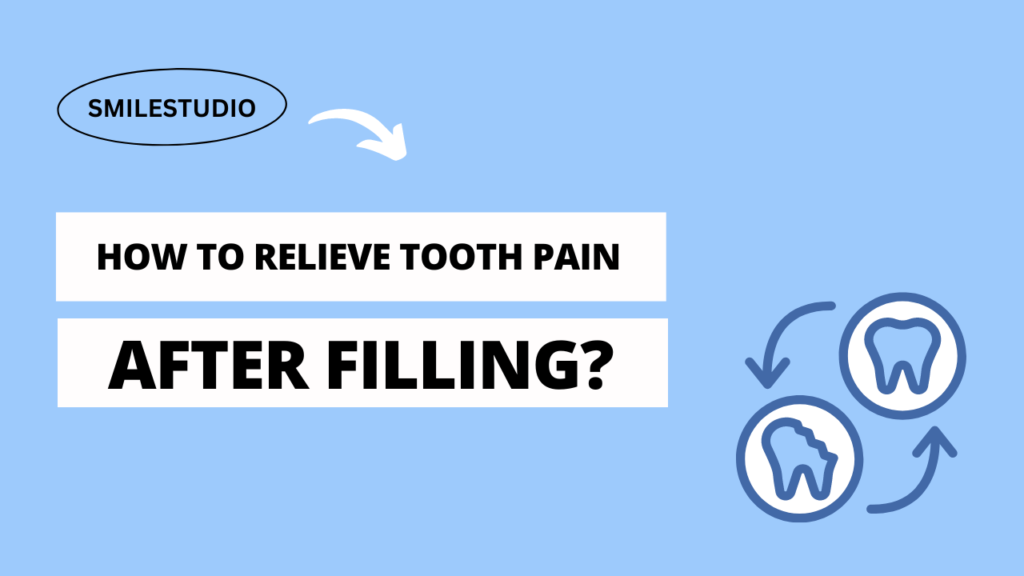Introduction
Tooth pain after a dental filling is a common experience that many people go through. This discomfort can be due to various reasons such as nerve irritation, an allergic reaction, or incorrect bite alignment. It’s important to note that this sensitivity is usually temporary and often subsides with time.
However, if the pain is extreme or if discomfort occurs with other symptoms, such as fever or swelling, it’s crucial to contact your dentist right away. The good news is that there are several ways to manage and relieve tooth pain after filling, ranging from over-the-counter pain relievers to certain home remedies.
In this article, we will explore why you might experience tooth pain after a filling, how to relieve tooth pain after filling, and when to see a dentist. Remember, while this pain is common, it’s not something you have to endure without relief. Let’s delve into the details.
Also Read: What to Do If Your Tooth Filling Fell Out?
Understanding Tooth Pain After Filling
Experiencing tooth pain or sensitivity after getting a dental filling is not uncommon. This discomfort can be attributed to several factors:
1. Nerve Irritation: The process of filling involves the dentist removing the decayed portion of the tooth, which can sometimes cause trauma to the tooth and nerves. Especially in the case of deep fillings, the procedure can get close to the nerve endings and cause irritation. As the nerve heals, the sensitivity usually subsides, which may take a few days or weeks.
2. Incorrect Bite Alignment: After a filling, it’s crucial that the tooth aligns correctly with the other teeth in the mouth. If the filling is too high, it can cause extra pressure when a person bites down, leading to pain and sensitivity. Minor sensitivity when biting down in the days following the procedure is common and typically goes away on its own.
3. High or Cracked Fillings: Fillings can come loose, fall out, or crack under certain conditions. A high dental filling can lead to malocclusion, misalignment in the jaw, and problems with your bite. A cracked filling can cause sensitivity and pain, especially when consuming hot or cold foods and drinks.
It’s important to note that while some sensitivity after a filling is normal, persistent or severe sensitivity is not. If you experience extreme pain, discomfort with other symptoms such as fever or swelling, or if the pain persists for more than a few weeks, it’s crucial to contact your dentist right away. They can assess the situation and take appropriate action, which might include adjusting the filling or prescribing medication to help manage the pain.
In the next section, we’ll discuss how to relieve tooth pain after filling and provide some practical tips to manage this discomfort. Stay tuned!
Also Read: Are Root Canals Painful? Busting Myths and Revealing Facts
Immediate Relief Measures
If you’re experiencing discomfort, here are some immediate steps you can take to relieve tooth pain after filling:
Over-the-Counter Pain Relievers: Over-the-counter (OTC) pain relievers such as ibuprofen (Advil, Motrin) or acetaminophen (Tylenol) can help manage the pain and inflammation. These medications are generally safe when taken correctly and can provide significant relief from dental discomfort. However, always follow the dosing instructions on the product label and consult with a healthcare provider if you have any concerns.
Cold Compress Application: Applying a cold compress to the cheek can help reduce swelling and numb the pain. Soak a clean cloth in cold water, wring it out lightly, and fold it into a pad. Hold it firmly against the affected area for about 20 minutes. This method helps reduce inflammation and provides temporary relief.
Avoiding Certain Foods: After a filling, your tooth may be sensitive to hot, cold, or sweet foods. Try to avoid these triggers as they could aggravate the tooth and cause pain. Instead, opt for soft foods that are gentle on your teeth.
Remember, these are temporary measures to relieve tooth pain after filling. If the pain is severe or persists for more than a few days, it’s important to contact your dentist for further evaluation.
Also Read: How Long Does Dental Filling Pain Last: All You Need to Know
How to Relieve Tooth Pain After Filling?
To ensure proper healing and prevent future pain after a dental filling, here are some long-term care strategies:
Brushing Gently Around the New Filling: After getting a dental filling, it’s crucial to brush gently, especially around the filled area, to prevent any damage or dislodging of the filling. Using a soft-bristled toothbrush and brushing in a circular motion can help maintain oral hygiene and ensure the longevity of the dental filling.
Using Toothpaste for Sensitive Teeth to Lessen Sensitivity: Tooth sensitivity is a common issue after a dental filling. Using toothpaste designed for sensitive teeth can help lessen this sensitivity. These toothpastes often contain ingredients like potassium nitrate and stannous fluoride, which can help soothe the nerves inside your teeth and protect the exposed soft, inner part of the tooth called dentin.
Regular Follow-Up Visits to the Dentist: Regular follow-up visits to the dentist are essential to ensure the filling is set correctly and to make any necessary adjustments. In most cases, a single follow-up visit is sufficient, but some procedures or dental appliances may require several follow-up visits. Regular dental check-ups can also help ensure that there are no other underlying issues and can prevent further damage to teeth.
By following these strategies on how to relieve tooth pain after filling, you can ensure a smooth recovery process and maintain good oral health. Remember, if the pain persists or becomes severe, it’s important to consult with your dentist immediately.
Also Read: Understanding the Impact: Can You Smoke After a Dental Filling?
When to See a Dentist
While it’s normal to experience some discomfort after getting a dental filling, there are certain signs that warrant a return visit to the dentist:
Persistent Pain That Doesn’t Subside After a Few Days: Most people experience mild pain after having a cavity filled, which typically goes away in a few days. However, if you continue to have pain or sensitivity for more than 4 weeks or if the pain worsens, it’s important to contact your dentist. This could be due to nerve irritation, incorrect bite alignment, or other issues that need treatment.
Increasing Discomfort or Signs of Infection Such as Fever or Swelling: Infections can cause symptoms such as fever, pain, swelling, and redness. If you notice any of these symptoms, especially if they’re accompanied by increasing discomfort, it’s crucial to see your dentist immediately. These symptoms aren’t typical after a filling and may signify a more serious problem.
The Filling Falls Out or Feels Loose: Fillings can come loose, fall out, or crack under certain conditions. Common reasons for a broken filling include biting down on a piece of hard material, decay around the filling, or habits like grinding your teeth. If your filling feels loose or falls out, it’s important to get it replaced as soon as possible.
Remember, these are guidelines on how to relieve tooth pain after filling and when to seek professional help. Always consult with your dentist if you’re unsure or if your symptoms persist. Your oral health is important, and your dentist is there to help ensure you maintain it.
When dealing with tooth pain after a filling, there are several home remedies and preventative measures you can consider to alleviate discomfort and protect your dental health.
Home Remedies for Temporary Relief:
1. Saltwater Rinses: A simple and effective way to reduce soreness and cleanse the area is to rinse your mouth with saltwater. This helps decrease inflammation and can aid in healing any minor irritations.
2. Clove Oil: Known for its pain-relieving properties, clove oil acts as a natural numbing agent. Applying a small amount of clove oil on a cotton ball to the affected area can help manage the pain effectively.
Preventative Measures:
1. Good Oral Hygiene: Regular brushing and flossing are crucial. Maintaining good oral hygiene helps prevent future dental problems that might require fillings.
2. Low-Sugar Diet: Reducing sugar intake can significantly lower the risk of tooth decay and dental discomfort.
3. Use of Mouthguard: If you grind your teeth or clench your jaw, wearing a mouthguard while sleeping can prevent damage to your teeth and fillings.
These remedies and preventative measures can help manage and reduce tooth pain after a filling. If pain persists or you experience severe symptoms, it’s important to consult your dentist, as there might be underlying issues that require professional treatment.
Wrap Up
Taking immediate and appropriate care of a new dental filling is crucial to ensure quick recovery and prevent further complications. Remember, most tooth pain after a filling is normal and temporary, but persistent or severe pain may signal an issue that needs professional attention. For any ongoing discomfort or questions about your dental health, SmileStudio is here to help.
Our team of dental professionals is committed to providing top-notch care and guidance to ensure your oral health is maintained.
Don’t hesitate to contact SmileStudio for any concerns or to schedule a follow-up appointment if your tooth pain persists. Your comfort and health are our top priorities.

FAQs
1. How long will my tooth hurt after a filling?
It’s common to experience some sensitivity or discomfort after getting a dental filling, typically lasting a few days to a couple of weeks. Most tooth sensitivity after a filling should subside within two to four weeks. If the sensitivity persists beyond this period or worsens, it’s advisable to consult your dentist.
2. How do you calm tooth pain after filling?
To manage tooth pain after a filling, you can use over-the-counter pain relievers like ibuprofen or acetaminophen. Other effective methods include gentle brushing with toothpaste designed for sensitive teeth, avoiding very hot or cold foods, and using a saltwater rinse to soothe the area.
3. What helps jaw pain after filling?
Jaw pain after dental work, such as fillings, can result from having your mouth open for an extended period. To alleviate this, you can apply a warm compress to the affected area, take over-the-counter pain medication, and try to relax your jaw muscles as much as possible. If the pain persists, consulting your dentist is recommended.
4. Do fillings take time to settle?
Yes, after a filling, it can take some time for your tooth to settle. The newly filled tooth might feel a bit different and sensitive as it adjusts. This settling period is typically brief, and any minor discomfort should diminish within a few days to a couple of weeks. However, if a filling is too high and affects your bite, it might require adjustment by your dentist.
5. Can I brush my teeth after filling?
You can brush your teeth after a filling, but it’s important to be gentle, especially around the newly filled area. Use a soft-bristled toothbrush and avoid being too aggressive, which can help prevent irritation and support healing.
6. What not to do after a filling?
After getting a filling, you should avoid chewing on hard, sticky, or chewy foods that could dislodge or damage the filling. It’s also best to steer clear of very hot or cold foods and drinks that could trigger sensitivity. Additionally, if you experience pain or discomfort, avoid using that side of your mouth for chewing until the sensitivity subsides.
For more detailed guidance, always consult with your dentist to ensure your specific concerns and symptoms are appropriately addressed.


